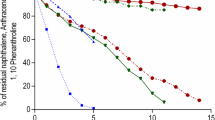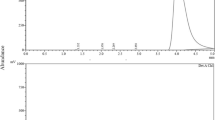Abstract
Pleurotus ostreatus degrades polychlorinated biphenyls (PCBs) with an increase of laccase activity. Laccases are well known for their detoxifying activity. We show, using reverse transcription polymerase chain reaction and a biochemical assay, that reduction in PCBs (di, tri, tetra, and penta) levels are correlated with an increase in laccase activity. P. ostreatus cultures were obtained from 0 to 30 days in the presence or absence of 7,100 mg/L PCBs (from transformer oil) and a surfactant. After each selected time cultures were withdrawn and remaining PCBs were determined, a maximal removal percentage of PCBs was obtained at 20 (63.5 ± 2.0) and 30 days (63.8 ± 4.6) post-induction. Also, the activity of the enzyme was analyzed and it was found to increase at 10 (6.9-fold) and 20 (6.77-fold) days post-induction in the presence of PCBs, as determined by its activity. Taken together, these data suggest that PCBs induce laccase expression and that laccase catalyzes PCBs removal.






Similar content being viewed by others
References
Beaudette LA, Davies S, Fedorak PM, Ward OP, Pickard MA (1998) Comparison of gas chromatography and mineralization experiments for measuring loss of selected polychlorinated biphenyl congeners in cultures of white rot fungi. Appl Environ Microbiol 64:2020–2025
Crinnion WJ (2011) Polychlorinated biphenyls: persistent pollutants with immunological, neurological, and endocrinological consequences. Altern Med Rev 16:5–13
Dietrich D, Hickey WJ, Lamar R (1995) Degradation of 4,4′-dichlorobiphenyl, 3,3′,4,4′-tetrachlorobiphenyl, and 2,2′,4,4′,5,5′-hexachlorobiphenyl by the white rot fungus Phanerochaete chrysosporium. Appl Environ Microbiol 61:3904–3909
Ericson MD (1999) Analytical chemistry of PCBs. CRC Press, Boca Raton
Faraco V, Giardina P, Sannia G (2003) Metal-responsive elements in Pleurotus ostreatus laccase gene promoters. Microbiol-sgm 149:2155–2162
Fujihiro S, Higuchi R, Hisamatsu S, Sonoki S (2009) Metabolism of hydroxylated PCB congeners by cloned laccase isoforms. Appl Microbiol Biotechnol 82:853–860
Gayosso-Canales M, Esparza-García FJ, Bermúdez-Cruz RM, Tomasini A, Ruiz-Aguilar GML, Rodríguez-Vázquez R (2011) Application of 2III7-3 fractional factorial experimental design to enhance enzymatic activities of Pleurotus ostreatus with high concentrations of polychlorinated biphenyls. J Environ Sci Health (Part A) 46:298–305
Guillén-Navarro GK, Márquez-Rocha FJ, Sánchez-Vázquez JE (1998) Production of biomass and ligninolytic enzymes by Pleurotus ostreatus in submerged culture. Rev Iberoam Micol 15:302–306
Jiang GX, Niu JF, Zhang SP, Zhang ZY, Xie B (2008) Prediction of biodegradation rate constants of hydroxylated polychlorinated biphenyls by fungal laccases from Trametes versicolor and Pleurotus ostreatus. Bull Environ Contam Toxicol 81:1–6
Kamei I, Kogura R, Kondo R (2006) Metabolism of 4,4′-dichlorobiphenyl by white-rot fungi Phanerochaete chrysosporium and Phanerochaete sp. MZ142. Appl Microbiol Biotechnol 72:566–575
Kubátová A, Erbanová P, Eichlerová I, Homolka L, Nerud F, Šašek V (2001) PCB congener selective biodegradation by the white rot fungus Pleurotus ostreatus in contaminated soil. Chemosphere 43:207–215
Luo W, D’Angelo EM, Coyne MS (2008) Organic carbon effects on aerobic polychlorinated biphenyl removal and bacterial community composition in soils and sediments. Chemosphere 70:364–373
Moeder M, Cajthaml T, Koeller G, Erbanová P, Šašek V (2005) Structure selectivity in degradation and translocation of polychlorinated biphenyls (Delor 103) with a Pleurotus ostreatus (oyster mushroom) culture. Chemosphere 61:1370–1378
Nikiforova SV, Pozdnyakova NN, Turkovskaya OV (2009) Emulsifying agent production during PAHs degradation by the White Rot Fungus Pleurotus ostreatus D1. Curr Microbiol 58:554–558
Novotny C, Vyas BRM, Erbanova P, Kubatova A, Sasek V (1997) Removal of PCBs by various white rot fungi in liquid cultures. Folia Microbiol 42:136–140
Palmieri G, Giardina P, Bianco C, Fontanella B, Sannia G (2000) Copper induction of laccase Isoenzymes in the ligninolytic fungus Pleurotus ostreatus. Appl Environ Microbiol 66:920–924
Paria S (2008) Surfactant-enhanced remediation of organic contaminated soil and water. Adv Colloid Interface Sci 138:124–158
Pointing SB (2001) Feasibility of bioremediation by white rot-fungi. Appl Microbiol Biotechnol 57:20–33
Palmieri G, Cennamo G, Sannia G (2005) Remazol brillant blue R decolourisation by the fungus Pleurotus ostreatus and its oxidative enzymatic system. Enzyme Microb Technol 36:17–24
Pozdnyakova NN, Nikiforova SV, Turkovskaya OV (2010) Influence of PAHs on ligninolytic enzymes of the fungus Pleurotus ostreatus D1. Cent Eur J Biol 5:83–94
Raeder U, Broda P (1985) Rapid preparation of DNA from filamentous fungi. Lett Appl Microbiol 1:17–20
Rigas F, Dritsa V, Marchant R, Papadopoulou K, Avramides EJ, Hatzianestis I (2005) Biodegradation of lindane by Pleurotus ostreatus via central composite design. Environ Int 31:191–196
Robinson KG, Ghosh MM, Shi Z (1996) Mineralization enhancement of non-aqueous phase and soilbound PCB using biosurfactant. Water Sci Technol 34:303–309
Rodrigues JLM, Kachel CA, Aiello MR, Quensen JF, Maltseva OV, Tsoi TV, Tiedje JM (2006) Degradation of Aroclor 1242 dechlorination products in sediments by Burkholderia xenovorans LB400(ohb) and Rhodococcus sp. Strain RHA1(fcb). Appl Environ Microbiol 72:2476–2482
Rodríguez E, Nuero O, Guillén F, Martínez AT, Martínez MJ (2004) Degradation of phenolic and non-phenolic aromatic pollutants by four Pleurotus species: the role of laccase and versatile peroxidase. Soil Biol Biochem 36:909–916
Rojas-Avelizapa NG, Rodríguez-Vázquez R, Enríquez-Villanueva F, Martínez-Cruz J, Poggi-Varaldo HM (1999) Transformer oil degradation by an indigenous microflora isolated from a contaminated soil. Resour Conserv Recy 27:15–26
Singer AC, Gilbert ES, Luepromchai E, Crowley DE (2000) Bioremediation of polychlorinated biphenyl-contamined soil using carvone and surfactant-grown bacteria. Appl Microbiol Biot 54:838–843
Stajić M, Persky L, Cohen E, Hadar Y, Brčeski I, Wasser SP, Nevo E (2004) Screening of laccase, manganese peroxidase, and versatile peroxidase activities of the genus Pleurotus in media with some raw plant materials as carbon sources. Appl Biochem Biotechnol 117:155–164
Stajić M, Persky L, Hadar Y, Friesem D, Duletić-Laušević S, Wasser SP, Nevo E (2006) Effect of copper and manganese ions on activities of laccase and peroxidases in three Pleurotus species grown on agricultural wastes. Appl Biochem Biotechnol 28:87–96
Tinoco R, Pickard MA, Vázquez-Duhalt R (2001) Kinetic differences of purified laccases from six Pleurotus ostreatus strains. Lett Appl Microbiol 32:331–335
Ullah MA, Kadhim H, Rastall RA, Evans CS (2000) Evaluation of solid substrates for enzyme production by Coriolus versicolor, for use in bioremediation of chlorophenols in aqueous effluents. Appl Microbiol Biotechnol 54:832–837
Vasil'eva GK, Strizhakova ER (2007) Bioremediation of soils and sediments polluted by polychlorinated biphenyls. Mikrobiologiia 76:725–741
Verdin A, Sahraoui AL-H, Newsam R, Robinson G, Durand R (2005) Polycyclic aromatic hydrocarbons storage by Fusarium solani in intracellular lipid vesicles. Environ Pollution 133:283–291
Yadav JS, Wallace RE, Reddy CA (1995) Mineralization of mono- and dichlorobenzenes and simultaneous degradation of chloro- and methyl-substituted benzenes by the white rot fungus Phanerochaete chrysosporium. Appl Environ Microbiol 61:677–680
Acknowledgments
We wish to thank Dr. Germán Cuevas Rodríguez from CIMAV, Chihuahua, Chihuahua, Mexico for allowing us to use the GC/MS.
Author information
Authors and Affiliations
Corresponding author
Rights and permissions
About this article
Cite this article
Gayosso-Canales, M., Rodríguez-Vázquez, R., Esparza-García, F.J. et al. PCBs stimulate laccase production and activity in Pleurotus ostreatus thus promoting their removal. Folia Microbiol 57, 149–158 (2012). https://doi.org/10.1007/s12223-012-0106-9
Received:
Accepted:
Published:
Issue Date:
DOI: https://doi.org/10.1007/s12223-012-0106-9




